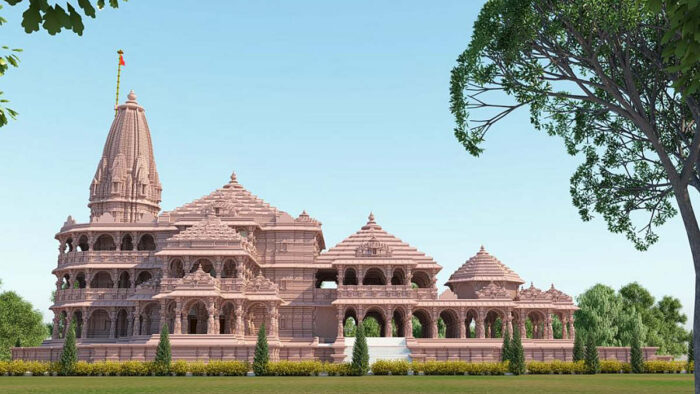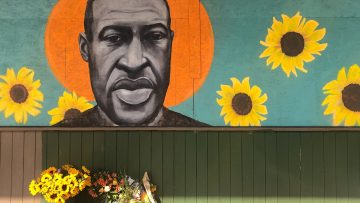The Ram Mandir of Ayodhya is not just an ordinary roadside temple that was brought down and re-constructed. The Babri Masjid built on top of the temple is a reminder of the terrible vandalism and conquest the sub-continent has faced. The verdict on this long, drawn out dispute turning more political was and is a sad commentary on the unwillingness of a few politically motivated groups to allow for an amicable settlement. It has therefore become the rallying point for a reassertion of the Hindu faith after centuries of suppression. Raghu Ananthanarayanan and a few others from Ritambhara try to listen to various Hindu voices and understand this issue from an Indic lens.
RA: This question of ‘just an old temple’ is not correct, but it has been a burning issue for 500 years or more. The facts are very clear, there was a temple below the Masjid and it has been called as the janmasthan even in the Muslim records. There was a continuous attempt to reclaim the sacred spot. The first set of people who tried to do that were the Sikhs because the place was very dear to Guru Nanak ji. My point is that it is not just a Hindu sentiment.
GI: So, it would be wrong to say that Hindutvadis were the ones trying to reclaim and agitate?
RA: Hindutva is a political response to a much deeper wish. No political action takes place in a vacuum. The freedom struggle did not happen because a few stood up, the nation was behind Gandhi ji and others. This perspective must be kept in mind else we would just have a political debate.
AR: As a Hindu I want to look at this issue from every angle possible to understand and process some of my own experiences. Like, being witness to the whole Mandal reservation issue during my school days and then witnessing the Ram Janma Bhoomi movement which resulted in the Babri Masjid being brought down, I experienced threats for the first time; because I stood up for some of my Muslim friends when they were being heckled at in Hyderabad’s public transport. I remember being called a ‘Muslim lover’ and was warned of bad consequences by some of my Hindu friends, the ones who were the loudest during the Mandal agitation and later in the Ram Janma Bhoomi movement time. These stigmas are still with me loud and clear.
HV: 8 years back I experienced the frustration of a group of businessmen who came together in a forum called Hindu Economic Forum in Wayanad. The common thread was that they were targeted to be driven out of business Muslim traders. I sense the same pain and even more in the Hindus of Kerala and elsewhere over various religious issues. The unarticulated hurts and the way they are downplayed; the betrayal of the political class post independence through minority appeasement and so on, are some of the issues I am sitting with. While people may only react on the political dimension of the temple, it is also important to have a wider understanding of the longer-term civilizational issues.
RA: Listening to both these reflections, 3 things strike me:
- The civilizational vs. political question in my opinion cannot be separated, and it has to be looked at in tandem.
- Why does the average educated Hindu find it so difficult to own up to his or her Hindu identity? What comes in the way of an average Hindu taking his/her Hinduness seriously?
- I feel that there is a fear that if the Hindus are serious about their identity, they will somehow be vengeful and act in the same way as they have been acted upon. I think this view is held by liberal Hindus also.
GI: Are you talking about Hindu assertiveness?
RA: Yes, assertion is looked as violence, which is not correct. So, I am interpreting this as a fear of any form of Hindu assertion. And this fear I am saying this fear exists in both the minds of the non-Hindus and the Hindus.
GI: This is what you called Apad dharma?
RA: Yes. I think the average Hindu is saying “I have learnt many tricks to avoid asserting myself over the centuries. Because if I assert myself I am caught in a deep double bind. In the colonised past, if I had asserted my Hinduness it would definitely attract reprisal. And if I did not assert it and held on to the feeling of being a Hindu very strongly, I would have to own up to my pain and victimhood of being oppressed”. I think the escape from this very difficult double bind is to hold on to a watered down and highly colonised ‘Sashi Tharoor idea of Hinduism’ (STH).
GI: But as a Hindu I can’t seem to escape it, because it keeps coming back to haunt me?
RA: Until it is fully resolved it will not go away. And if it is not resolved in meaningful ways, it will keep alternating between an escapist acceptance of violations or a mindless reactivity. This will happen within the individual or get reflected in the polarization among the Hindu community. One set will be the STH variety and the other the extreme elements of the Sangh Parivar.
AR: I think I understand what you mean. My ancestors were fort keepers on the Konkan coast, near Goa. We were driven out once the Portuguese invaded and we often call ourselves ‘cowards’ despite being Kshatriyas. There is a struggle in me that swings between various feelings when I own up to my heritage: helplessness, shame, rootlessness, anger and a deep dilemma of how do I find a meaningful way to anchor myself to an important part of my identity.
RA: I am interpreting your dilemma as apAd dharma– where you do not fight because the fight will be detrimental to you in the long term. You may withdraw and avoid the conflict with the underlying assumption that sooner or later you will come back and reclaim your heritage. But this never happened. A kshatriya’s job is to die for one’s cause and if you do not then the core of your kshatriya identity will be questioned. The worst thing for a soldier is to die with a weapon stuck to his back. It is glorious to die with a weapon pierced through your chest.
AR: I guess it is the Indian way to retreat or give space when one does not agree with the other. Isn’t it?
RA: Yes, Buddhists and Hindus both do that. In fact, there is an interesting story where a group of people go to Buddha and tell him about two preceptors who are fighting in the matter of the doctrine, so they wanted his help to solve it. Buddha listened to both of them and said, “I do not know who is right, so those who feel that this person is correct, follow him and those who feel the other person is correct, follow him. And come back after practicing the teachings for a few years.” Now, I cannot imagine something like this taking place in Abrahamic religions. I think one of the more serious double binds is “if I act from my idea of giving space to the other, I am damned (because the other is focused on colonizing my space); if I don’t, I become like the other and I am still damned”.
Many communities in India who claim their roots elsewhere but are settled somewhere else in the country, feel exiled from their roots. In Niligris, where I reside, the Badagas ran away from Tipu Sultan and settled here. They find it very hard to speak about their heritage with pride.
GI: Even conversions like the ones faced by Goan inquisition also fall under this category?
RA: Yes, the Hindus were tortuously converted. The violence was extremely horrific. I know a Jesuit priest who gave up the robes when he understood the history and truth of his family.
GI: The famous Konkani folk song Hanv Saiba Poltoddi Vetam, Dalmulea lognak(u) vetam, is a song where the person singing wants to cross the river to attend a wedding of a friend Damu (a metaphor for a Hindu) where it is safe and away from the Portuguese. “I am prepared to give everything I own like my bangles and gold to the boatman to take me across the river.” It is a very sad song at one level but Bollywood adapted it into the movie Bobby and made it a happy one.
RA: Wow! Do you see how the Apad dharma mind works! Many communities in South India have songs about their homes , deities and temples they left behind. In Tamil Nadu, many local communities hold the Mahabharata Koothu tradition as the story of exile and Draupadi as the symbol of immense resilience.
AR: Our original kuladevatas are in Goa but now the family temples are in Kerala where we ran off.
RA: Yes, the murtis would be waiting to go back home. There is a case about Rama of Ayodhaya also; apparently the original murtis of Rama, Sita and Lakshmana are in Sadguru Samartha Narayana Maharaj Ashram, Karnataka.
GI: What do you mean when you say ‘the deity is waiting to go back home?’
RA: The deity is a projection of my deepest aspiration. The importance is not on the form but the qualities projected on to them. The kuladevatas will have the family’s aspirations and qualities. Each of them have their own sampradAya, rituals, celebrations and negative qualities that need to be controlled etc. Dr Meenakshi Jain has written eloquently about this process of protecting deities from destruction in the “Flight of the Deities”.
PN: The shadows of the Gods are never spoken of. By ‘shadow’ I mean that the God/Goddess enables me defeat the asura within and outside. What do I do when I know that the deity my community carries around has been defeated? Then there is a loss of faith on the one hand, smoldering and long standing hurt as well as a yearning to reclaim the heritage on the other hand.
GI: The Ram Janmabhoomi could have been solved or given back to the Hindus long back had it not been for the political interference. Even the Muslims said ‘it doesn’t matter to us’ because they don’t have a specific area for worship except for the Kabba. KK Mohammed one of the people involved in excavation the site has written about this.
RA: Yes, we never just pray to an ‘idol’. The temples are sacred sites chosen by some Rishi or Siddha, who felt the energy of a deity. The temple, murtis and puja are a way to keep that energy alive. Imagine the energy of hundreds of people thriving and multiplying in that location? You cannot completely wipe this aspect of the Hindu culture and say ‘pray at home’ or ‘pray anywhere.’ We don’t actually worship the deity; we worship the power at the sacred site, and give a form to this power.
GI: Do we project our negativities or qualities on certain asuras? Just like we project on the Gods?
RA: The asuras also have a specific form and some who have fought Shiva, Vishnu have a generic form. Take Ravana for instance. He is an extraordinary person well-versed with music and astrology, he is also a great scholar and obviously capable of relentless practice. But he assumes that the personal self (called asmita in Yoga) is the source of the power. This causes a loss of integration within – represented by ten heads, twenty arms and so on. Shiva and Vishnu are all archetypal forms and energies in us waiting to be awakened. For example, at the feet of Nataraja we have the dwarf asura apasmAra, he is a sign of avidyA and is ignorant of his true nature. His face is always lit up in any Nataraja form because Shiva helps him remember his true nature of ‘I am Shiva’. Thus, every God has an asuric form to overcome. Hence, to reclaim my divine self, I need to hold my tradition regarding my kuladaivam in pride.
AR: We have traced our kuladevata back to Goa, Our family deity is Ramanatha, who is supposedly a form of Shiva. But for many branches our family settled around Udupi, the istadevata is Krishna. I believe that the settler-warriors gave their allegiance or adapted their traditions in line with the prevailing power structures/traditions of the land which sheltered them. In all this there is a deep yearning to find the mula nAga, or the origin. Unfortunately, these questions are never answered fully.
RA: This is apAd dharma in action, your family finally settles in Udupi but you cannot claim that you are Shaivites because you are guests in this land. So, you pay allegiance to the deity of the land but you still hold your deity close to your heart and continue the quest. You need to be true to your dharma, that whoever is giving you food or shelter, you need to be dharmic towards them. It is beautiful and holds pathos at the same time.
(To be continued…)
(Image credit: ThePrint)
Disclaimer: The opinions expressed in this article belong to the author. Indic Today is neither responsible nor liable for the accuracy, completeness, suitability, or validity of any information in the article.










